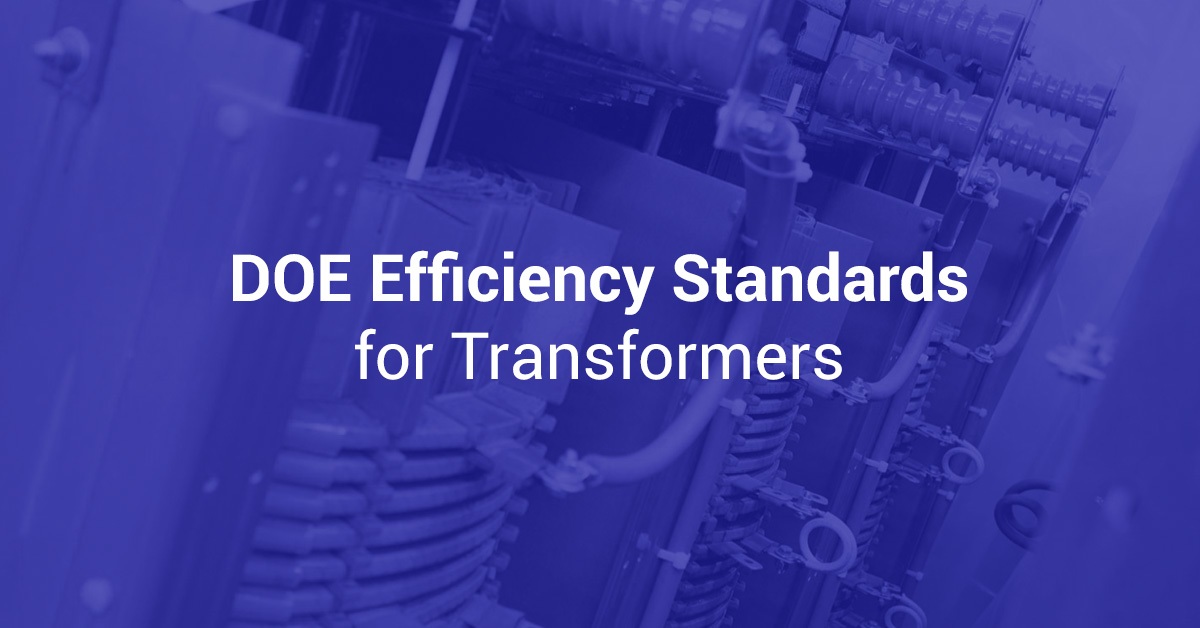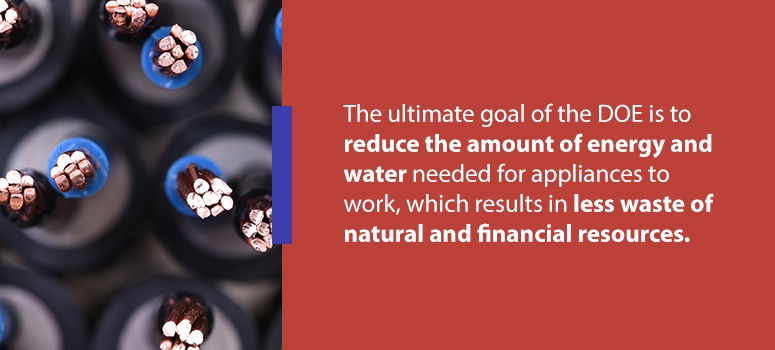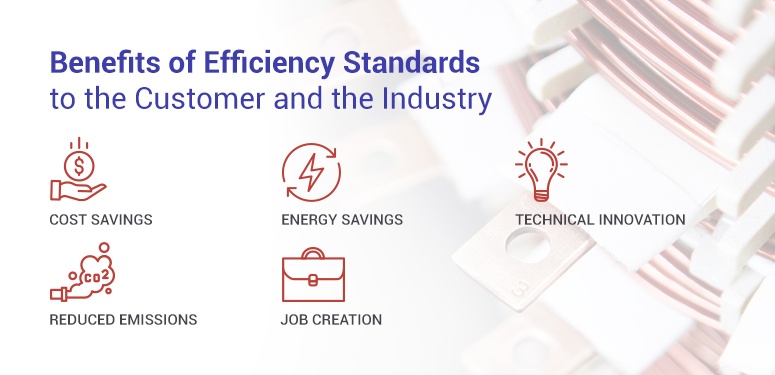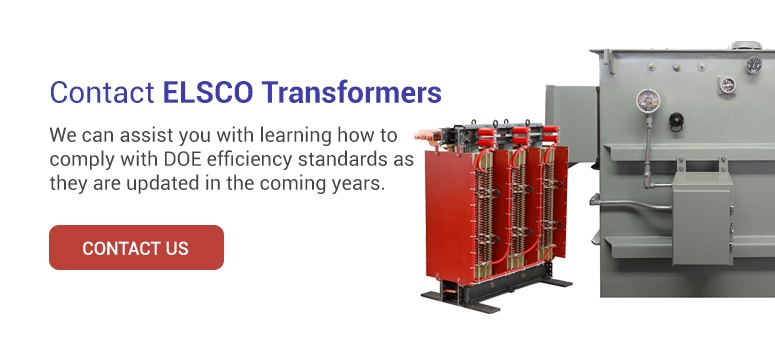
- by Todd Benadum
- March 27, 2024
- Dry Type Transformers, Padmount Transformers
Jump To:
- What Are the DOE Efficiency Standards?
- Benefits of Efficiency Standards to the Customer and the Industry
- How to Comply With Efficiency Standards
- Impacts of DOE Regulations and Compliant Transformers
- Transformers Exempt From DOE Efficiency Standards
- The Future of DOE Efficiency Standards
More than 40% of the energy used in the United States is consumed by building operations, including the electrical equipment and appliances within those buildings. While this equipment is essential to daily functionality in homes and business locations, ensuring that these appliances use energy efficiently is also gaining importance.
Since the Energy Policy and Conservation Act of 1975 was amended, the U.S. Department of Energy (DOE) has been responsible for ensuring that appliances meet a minimum standard of energy and water efficiency. The DOE rules apply to over 60 different product types used in public and commercial applications, including transformers.
Distribution transformers play a significant role in daily life, transforming the final voltage in an electric power distribution system. Transformers convert power into a form usable within buildings, making it essential for public, commercial and industrial applications. Since 2007, the Department of Energy has played a role in regulating the efficiency of transformers, and they’ve regularly updated their standards every several years.
The most recent updates are from 2016, deployed with efficiency and consumer benefits in mind. In December 2022, the DOE proposed a new set of energy-efficiency requirements for distribution transformers that, if approved, should take effect in 2027. However, a rule proposed in January 2023 could affect the 2027 regulations. This proposed rule has bipartisan support and, if approved, would halt the 2027 regulations or involve a slower phase-in of the policies.
What Are the DOE Efficiency Standards?
The Department of Energy establishes energy-efficiency standards under the Appliance and Equipment Standards Program — a suite of programs under the Building Technologies Office (BTO). The Appliance and Equipment Standards Program helps reduce energy and resource consumption in buildings by maximizing the energy efficiency of appliances — including transformers.
More precisely, the DOE efficiency standards for transformers are federal government-imposed regulations intended to reduce the amount of energy and water needed for equipment to work, which results in less waste of natural and financial resources. The standards have several different classifications, and each of those is further split according to whether they apply to single- or three-phase transformers.
While transformers have always been efficient, DOE standards define the minimum efficiency levels transformer manufacturers must meet to improve the resilience and efficiency of America’s power grid, reduce energy bills and decrease domestic carbon dioxide (CO2) emissions. Because efficiency standards still need to be realistic, the DOE considers many factors when reviewing and developing the standards. These include:
- Technical feasibility: The DOE takes into consideration recent technological changes and standards and what is feasible with these new innovations.
- Cost efficiency: While certain types of technology may be ideal for improving energy efficiency, not all options will be cost-effective for manufacturers or consumers. For this reason, the DOE takes current market costs into consideration when setting basic standards.
- Existing standards: The DOE often uses existing standards as a template for future standards. This can include both federal and state standards, as many states choose to set their own standards outside of federal mandates.
- Stakeholder input: The DOE takes input from a variety of stakeholders, including manufacturers, energy experts and consumer advocates.
Once the new standards are completed, they go into effect within the next few years, at which point it is the responsibility of manufacturers to read and comply with the new standards.
Benefits of Efficiency Standards to the Customer and the Industry
The benefits of DOE efficiency standards for transformers and other appliances are significant and widespread, positively affecting consumers and the industry at large. Below are some of the primary benefits of efficiency standards.
Cost Savings
DOE standards are designed to be cost-effective for consumers. Manufacturers are required to ensure that any increases in appliance and equipment prices will be recovered through electricity savings within the lifetime of the product.
According to the 2016 DOE standards, American consumers are expected to save a cumulative amount of $1.7 trillion between 1987 and 2030. The proposed standard, updated in 2022, could lead to even greater results — it’s estimated to generate over 10 quads of energy savings. This translates to $15 billion in total energy bill savings over 30 years.
However, it’s important to mention that if the aforementioned bill to stop or slow down the 2022 regulations passes, these savings would change.
Energy Savings
Energy-efficient appliances use less energy-intensive technologies, reducing the amount of electricity and water used in each product. This benefit is particularly important for transformers, as transformers work continuously. Over the next 30 years, improving transformer efficiency is expected to reduce energy needs by 3.83 kilojoules, which is the equivalent of the annual energy usage of 40 million American households. Enhanced transformer efficiency also decreases energy waste and the demand for power grids.
Reduced Emissions
Energy-efficient appliances help reduce greenhouse gas emissions. By reducing electricity consumption, energy-efficient appliances require less energy generation from power plants, which often use fossil fuels. According to the DOE’s BTO, the standards implemented since 1987 have avoided 2.3 billion tons of CO2 emissions, equivalent to the annual emissions of 500 million cars.
The 2016 updates reveal that over the next 30 years, improving transformer efficiency alone is expected to eliminate another 264.7 million metric tons of CO2 emissions. This amount is equal to 51 million annual automobile emissions. On top of these emissions, improving transformer efficiency is expected to avoid the emission of 203,000 metric tons of nitrogen oxides, 182,900 metric tons of sulfur dioxide and 1,200 pounds of mercury.
The 2022 proposed standards are estimated to reduce CO2 emissions even further — by 340 million metric tons over the next 30 years. That’s equivalent to 90 coal-fired power plants. Reduced greenhouse gas emissions have a significant environmental impact and contribute to the global sustainability goals.
Technical Innovation
Appliance and equipment standards ensure that manufacturers transition away from outdated technology more quickly, pushing them toward innovative and efficient product designs that can help the market as a whole. For instance, both the DOE 2016 standards and 2022 proposed standards recommend the use of amorphous steel in advanced transformers, moving away from traditional, grain-oriented steel. Amorphous steel is preferred because it boasts the lowest losses.
Job Creation
While manufacturers are expected to lose up to 8.4% of their net value over the next 30 years, it is highly unlikely that manufacturers will see any plant closings or significant losses of employment. In fact, while standards can increase manufacturing costs, they create jobs in research, manufacturing and installation. The American Council for an Energy-Efficient Economy (ACEEE) estimates that 340,000 jobs were attributed to appliance standards in 2010 and that by 2030, this number could jump to 380,000 jobs in the United States.
How to Comply With Efficiency Standards
DOE guidelines for transformer efficiency started with the 2010 guidelines and the 2016 standards use the baseline set by the 2010 guidelines. The 2022 proposed standards take into account both standards, which are identical in scope, compliance methodology and exceptions. They outline efficiency requirements according to the type of transformer. The only significant change is in the required efficiency levels.
While DOE 2010 regulations aimed for 98.36% to 99.49% transformer efficiency ratings, the 2016 regulations increased the expectation to between 98.70% and 99.55%. This change primarily impacted the quality of materials and the weight of transformers, which increased both the price and the efficiency of transformer products. The DOE’s recent proposal aims to force many new transformers to use newer core technology to conserve more energy and reduce costs. According to the proposed standards, many new transformers from 2027 will have amorphous steel cores, which are more energy-efficient than grain-oriented electrical steel cores.
Prior to the implementation of the 2022 proposed DOE efficiency standards, compliance with 2016 regulations is mandatory. Any transformer shipped after December 12, 2015, must conform to the new standard, and the production, import and sale of non-compliant products is prohibited. While installed equipment already owned by customers is not required to meet this standard, manufacturers cannot sell any more non-compliant products, as the grace period for selling these products after the implementation of the 2016 regulation has passed.
Compliance with 2016 DOE standards is evaluated against the transformer efficiency formula that calculates the transformer’s efficiency by comparing the power used to the power supplied.
Impacts of DOE Regulations and Compliant Transformers
The 2016 Department of Energy efficiency standards have changed transformer designs and preferences in substantial ways. The most notable impacts are listed below:
- Transformer weight and dimensions: New standards have affected the overall weight and size of transformers. Overhead and three-phase transformers are particularly affected, with overhead transformers increasing in weight by 4% to 8% and three-phase transformers increasing by 5% to 6%.
- Material costs: Efficient transformers require higher core material quality. Higher grades of conventional grain-oriented electrical steel and amorphous metals are particularly favored, with the former being the cheapest option. Both, however, are more expensive than previous materials allowed under the 2010 standard, which has significantly increased production costs. The increased production costs are expected to be recovered in the long term as a result of higher efficiency and lower power consumption costs.
- Installation practices: Changes in size and weight for transformers have impacted the installation practices used for transformers. Pads for transformers have been redesigned to accommodate new dimensions and transportation and handling practices have changed to account for the new weight and size.
Transformers Exempt From DOE Efficiency Standards
While the DOE efficiency standards apply to most distribution transformers, the standards don’t apply to the following types:
- Autotransformers
- Grounding transformers
- Regulating transformers
- Sealed transformers
- Testing transformers
- Welding transformers
- Rectifier transformers
- Non-ventilated transformers
- Drive (isolation transformers
- Machine-tool (control) transformers
- Special-impedance transformers
- Uninterruptible power supply transformers
- Transformers with a tap range of 20% or more
The Future of DOE Efficiency Standards
The DOE proposed new energy efficiency standards for transformers in December 2022 that, when approved, will be implemented in 2027. The goal of the updated standards is to improve the power grid’s resilience, reduce consumer utility bills and lower CO2 emissions. To support the proposed standards, the DOE, funded by President Biden’s Bipartisan Infrastructure Law under the Energy Act of 2020, is finalizing attempts to extend rebate programs to reduce the cost of replacing older distribution transformers.
The rebates valued at $20 million will be offered to manufacturers, hospitals, utilities and other groups that finance equipment upgrades. Additionally, the government has invoked the Defense Production Act to address the supply chain challenges affecting the manufacturing of key electric grid components.
Contact ELSCO Transformers for More
While the DOE efficiency standards for transformers are extensive, they pose significant benefits to consumers and the industry. It’s essential to remember, however, that efficiency requirements can change, and the DOE is more likely to increase requirements rather than reduce them. To take on new regulations, you need to work with manufacturers that can accommodate new regulations effectively and assist their customers with new transformer efficiency standards and ratings. ELSCO Transformers is one such manufacturer.
If you need high-efficiency transformers that comply with DOE regulations, ELSCO can help. We can assist you with learning how to comply with DOE efficiency standards as they are updated in the coming years, providing high-quality transformers with excellent warranties. On top of our quality products, we provide comprehensive support with a staff of experienced specialists who can help you with any questions.
Contact ELSCO today to learn more about our products or request a quote.







